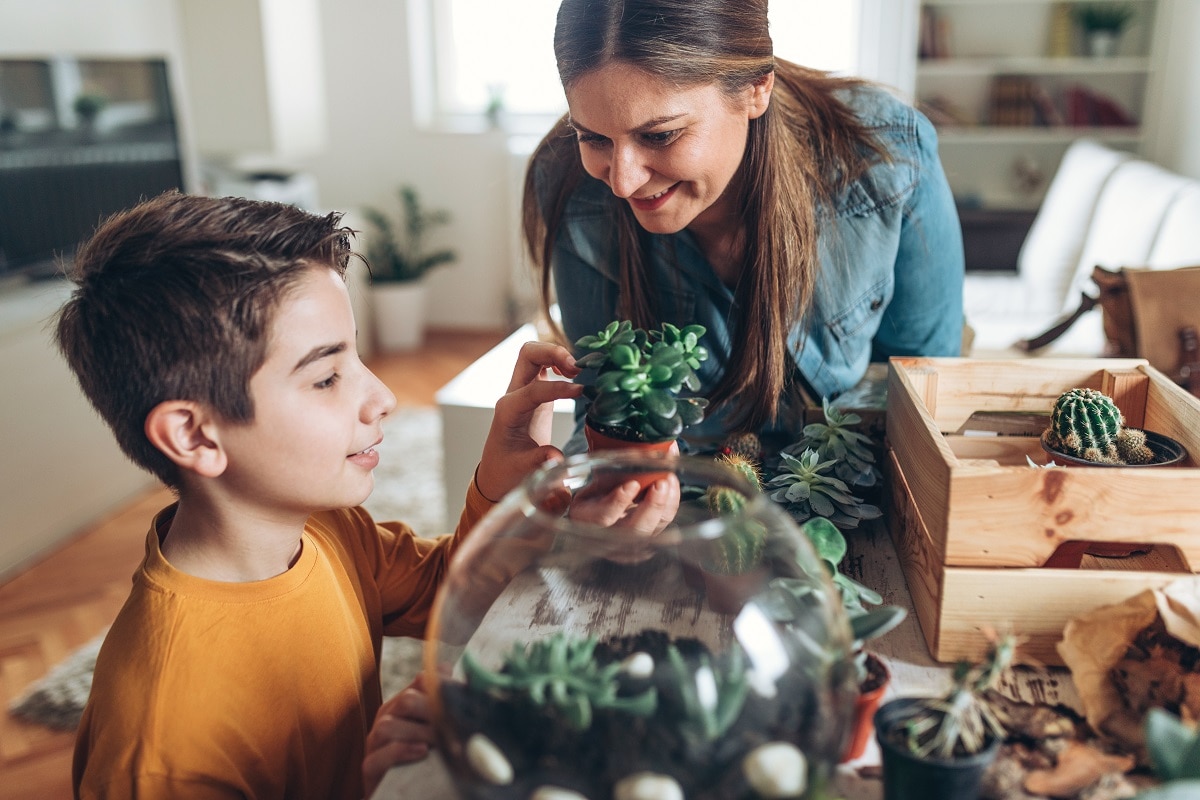by freelance writer Riley Herder
For those with even the slightest green thumb, a terrarium is a good choice for a variety of reasons. You may desire a garden but have limited outdoor space. Perhaps you want the satisfaction of having plants but are nervous about the level of commitment many potted plants and outdoor plants require. Or it could be that—like my family—you have a pet inside that likes to eat your plants, so the only way to grow anything indoors is in a terrarium.
Whatever your reason, a terrarium can be fun for the whole family, and is super easy (and cheap) to set up. Follow these four easy steps to get started.
You can grow all kinds of plants inside a terrarium. Ideally, it is best to pick the kinds of plants and plant systems you intend to have before choosing your container, because certain plants are better suited for certain types of container. If you already have a container, it is mostly important to note whether it is open style or closed—which we will cover below—and pick plants accordingly.
The kind of light exposure you have in the area your terrarium will go determines which plants you should go with, as well as what kind of container. Open terrariums are best for areas with lots of light exposure. But avoid placing a terrarium in full sun. If your space receives a good amount of sunlight, succulents might be your best bet. Pick low maintenance succulents such as Jade, Sempervivum, and Haworthia. In medium light, you can go with an open or closed container. Ferns are a great choice for either one. Also, you can’t go wrong with nice slow growing ground covers such as baby’s tears. Darker lit spaces are best suited for a closed container filled with various mosses. Sheet moss and mood moss are popular choices for a low light terrarium.
>> Need some help in the garden? Find a gardener here.
2. Choose a container
The sky’s the limit when it comes to a container. As mentioned above, the two main distinctions are open and closed. Outside of that, a terrarium can be any shape imaginable and whatever size meets your needs. Tons of great terrariums are available either online or at your local garden store—these make for attractive options. But you can save money and add rustic charm by recycling an old glass fish bowl, or finding an eclectic glass jar in an antique store for a bargain. Just know that a DIY container will not have a drainage system built in and you’ll need to set up your own.
3. Prepare the soil and drainage system
The step that requires the most preparation is getting your layers ready before planting. Just like planting outdoors, your plants need to be in a proper soil setting with adequate drainage to survive. The bottom layer should be your drainage. This is super important—without it, your roots will sit in excess water and quickly rot. Lay down at least an inch of small gravel, coarse sand or pebbles. Add a couple more inches for a larger container.
Next, it is a good idea to add in a small layer of activated charcoal. Activated charcoal is composed of carbon-rich materials burned at high temperatures. This acts as an air filter to clean the atmosphere of fumes let off by decomposing organic matter within the terrarium. This is especially important in enclosed terrariums that do not cycle air from outside the container.
You are almost ready to add soil! But if you add soil at this point, it will only sink down into the beneath layers and become a soggy mess. Create a protective layer with a thin covering of sphagnum moss, and this will not be a problem. Lastly, put in the soil. Quality of soil makes or breaks your terrarium. For extra nutrients, use either potting soil with potting sand mixed in as well as some humus: about one part of sand, one part of humus to two or three parts of soil. You can also purchase pre-mixed soil specially made for terrariums, but this one can be a bit costlier.
4. Plant and maintain your plants
Planting your terrarium is simple—no special tools required. You can just dig a small hole with a spoon where you want the plant to go. Then take your plant out of the pot and lower it in. Don’t loosen the roots as you would when planting in a garden—that causes many plants to grow more quickly, which is not the desired effect in an enclosed container. Pack a little soil around the bottom, but don’t overcrowd it.
As mentioned above, maintaining a terrarium is incredibly easy. You will only need to water an open container once a week or so. Enclosed containers even less often. Check out the glass every now and then to inspect the condensation. A little condensation is normal. If you see large drops accumulated on the glass, you can leave the lid off for a bit and not water it again until the condensation decreases to a normal amount. But for now, enjoy!
